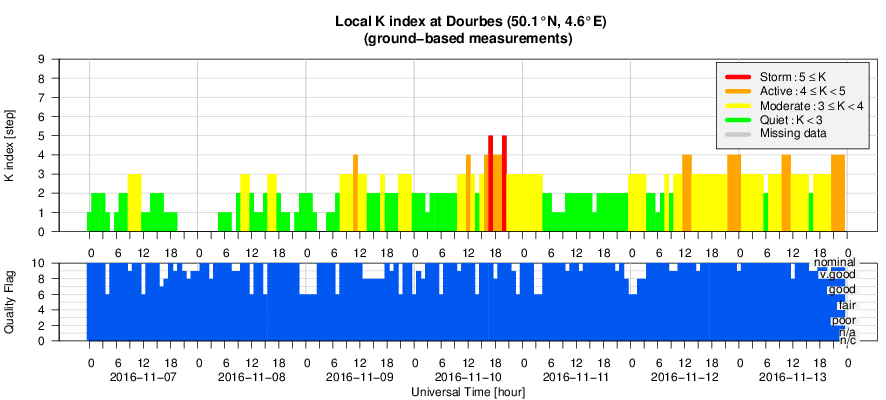- Table of Content
- 1.The first Earl...
- 2.PROBA2 Observa...
- 3.Review of sola...
- 4.The Internatio...
- 5.Geomagnetic Ob...
- 6.Review of iono...
- 7.Future Events
2. PROBA2 Observations (7 Nov 2016 - 13 Nov 2016)
3. Review of solar and geomagnetic activity
4. The International Sunspot Number
5. Geomagnetic Observations at Dourbes (7 Nov 2016 - 13 Nov 2016)
6. Review of ionospheric activity (7 Nov 2016 - 13 Nov 2016)
7. Future Events
The first Early-Career Day
On 25 October 2016, the first Early-Career Day (ECD) was organized at the Space Pole in Uccle, the main idea for such an event - bringing together the Early-Career staff members of all three institutes - being to improve the network of the Space Pole. Soon, an organization team of eleven EC staff members formed, composed of 5 representatives from ROB, 4 from BISA and 2 from RMI. For the first ECD, 38 participants (19 female and 19 male) registered, and several non-EC staff members joined in addition for the evening reception. The participants came from the Royal Observatory of Belgium (ROB), the Belgian Institute for Space Aeronomy (BISA), the Royal Meteorological Institute (RMI), The Université Libre de Bruxelles (ULB), and the Katholieke Universiteit Leuven (KU Leuven).
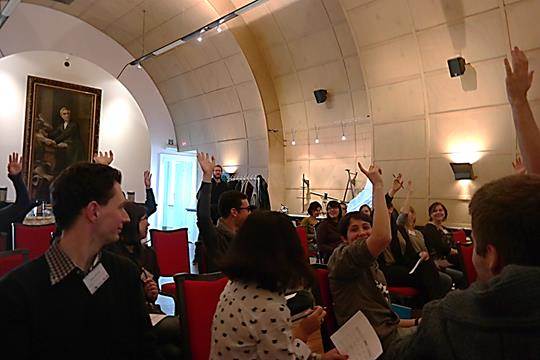
The ECD began with an introduction game, where participants already started to get to know each other personally. During a speed-networking event, all participants talked with each other about their work and current projects. For this, everyone had to bring a conversation starter along (a book, a part of an instrument, a picture of the lab etc.). In the afternoon, we organized a tour of the three institutes with the help of the outreach representatives of the institutes, visiting the weather park, two telescope domes, the clean rooms of RMI and BISA, and the B.USOC (http://www.busoc.be/ ).
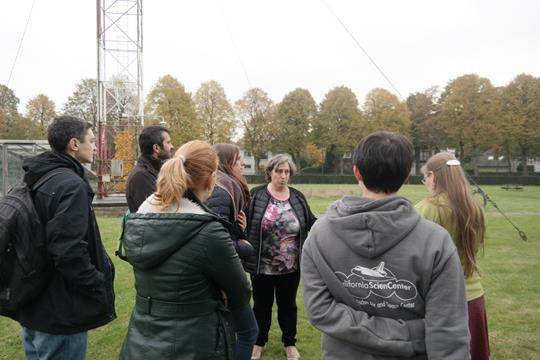
After the tour, participants could choose between two 1.5h workshops. The proposal and project management workshop, held by Caroline Kussé from ROB, gave an overview of how to write a successful research proposal, and how to manage larger projects. The second workshop was on publications and was organized as a panel discussion, with esteemed scientists from ROB and BISA (Véronique Dehant, Ozgur Karatekin, Jan Janssens, Viviane Pierrard and Norma Crosby) with different backgrounds in publishing, reviewing and editing. The day ended with an evening reception, which was open to all staff members of the Space Pole.

The day was a big success. This became also clear during a short feedback session, when participants were asked about what they would like to change for a future ECD, and how they would like to see the network built up. Based on their feedback, several suggestions were retained for future ECDs.
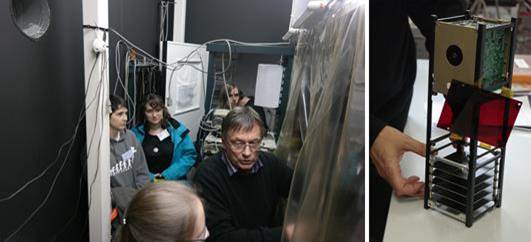
We are looking forward to organize more networking events in the future, and would like to take the opportunity to thank all three institutes ROB, BISA and RMI for their support, and to thank the IUAPs Planet Topers and CHARM for their generous co-hosting of the evening reception as well as all personnel helping with the organization, which made the first ECD such a successful and rewarding event.
With best regards,
The Early-Career Group of the Space Pole
Gaël Cessateur (BISA), Charles Delvaux (RMI), Elke D'Huys (ROB), Romain Ingels (RMI), Graciela Lopez (BISA), Dries Nicolaes (ROB), Lena Noack (ROB), Jérémy Rekier (ROB), Bart Vleminckx (ROB), Jonas Vlietinck (BISA) and Minqiang Zhou (BISA)
PROBA2 Observations (7 Nov 2016 - 13 Nov 2016)
Solar Activity
Solar flare activity was very low during the week.
In order to view the activity of this week in more detail, we suggest to go to the following website from which all the daily (normal and difference) movies can be accessed: http://proba2.oma.be/ssa
This page also lists the recorded flaring events.
A weekly overview movie can be found here (SWAP week 346) http://proba2.oma.be/swap/data/mpg/movies/weekly_movies/weekly_movie_2016_11_07.mp4
Details about some of this week’s events, can be found further below.
If any of the linked movies are unavailable they can be found in the P2SC movie repository here http://proba2.oma.be/swap/data/mpg/movies/weekly_movies/
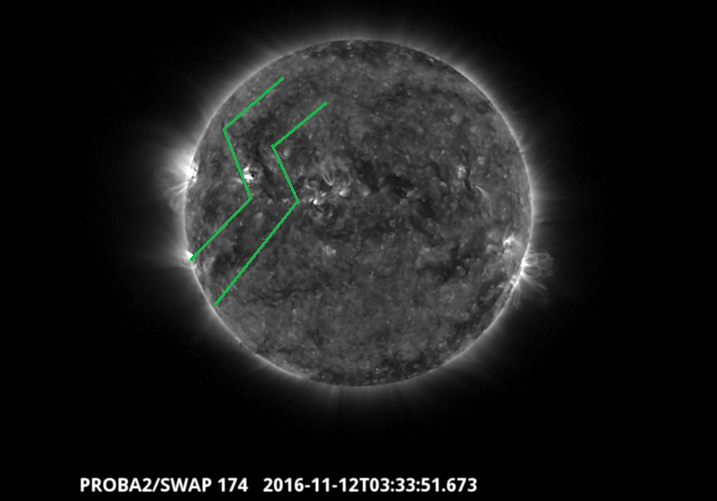
A coronal hole stretch from south pole to north of the equator dominated the solar disk since Nov 12
Find a movie of the events here (SWAP movie)
http://proba2.oma.be/swap/data/mpg/movies/20161112_swap_movie.mp4
Review of solar and geomagnetic activity
Solar Activity
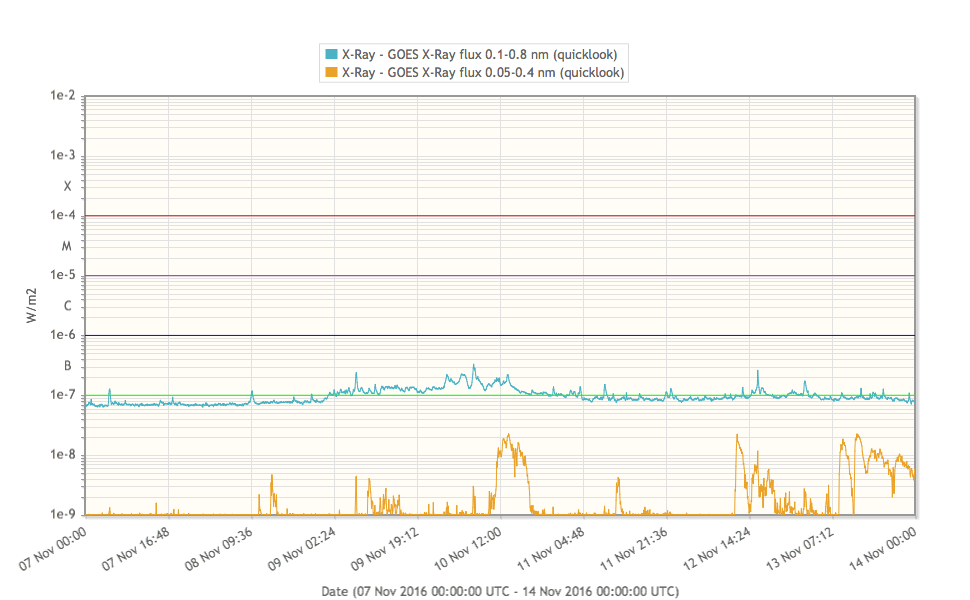
The Sun released no C and only low B flares during this week, while the GOES X ray background was near B1 level.
Geomagnetic Activity

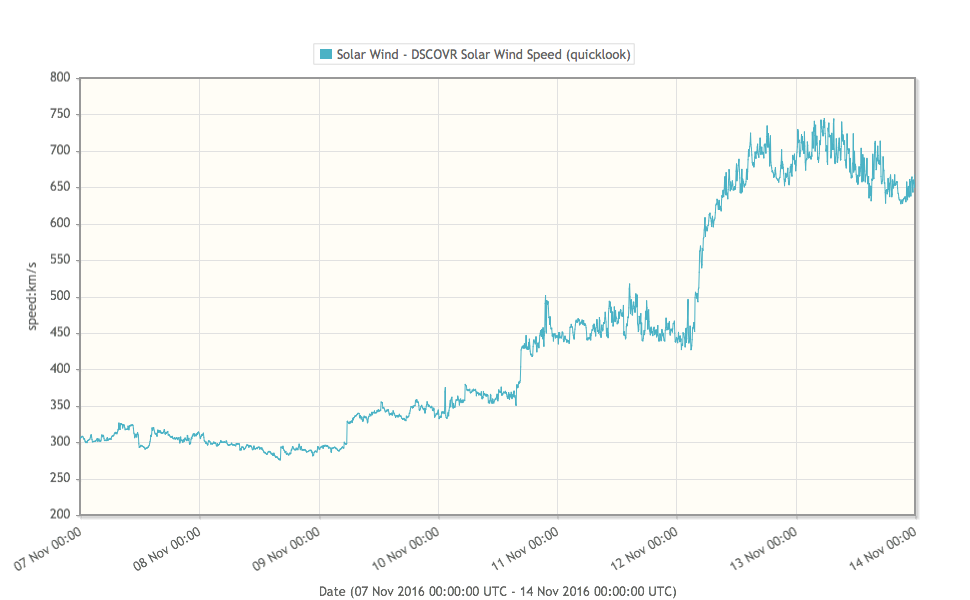
After nominal low speed solar wind conditions, a small shock in the solar wind was registered by DSCOVR at 5:43 UT on November 9. Solar wind speed jumped from about 300 to 330 km/s, while the magnitude of the Interplanetary Magnetic Field (IMF) jumped from about 4.5 to 7.5 nT. Proton density jumped from about 12 to 25 particles per cc. This was probably due to the arrival of the November 5 CME.
Solar wind speed jumped again from about 370 to 430 km/s at 16:45 UT on November 10, and increased sharply from about 450 to a maximum value of 760 km/s at 3:40 UT on November 12, which marks the arrival of an expected high speed stream associated with a negative coronal hole.
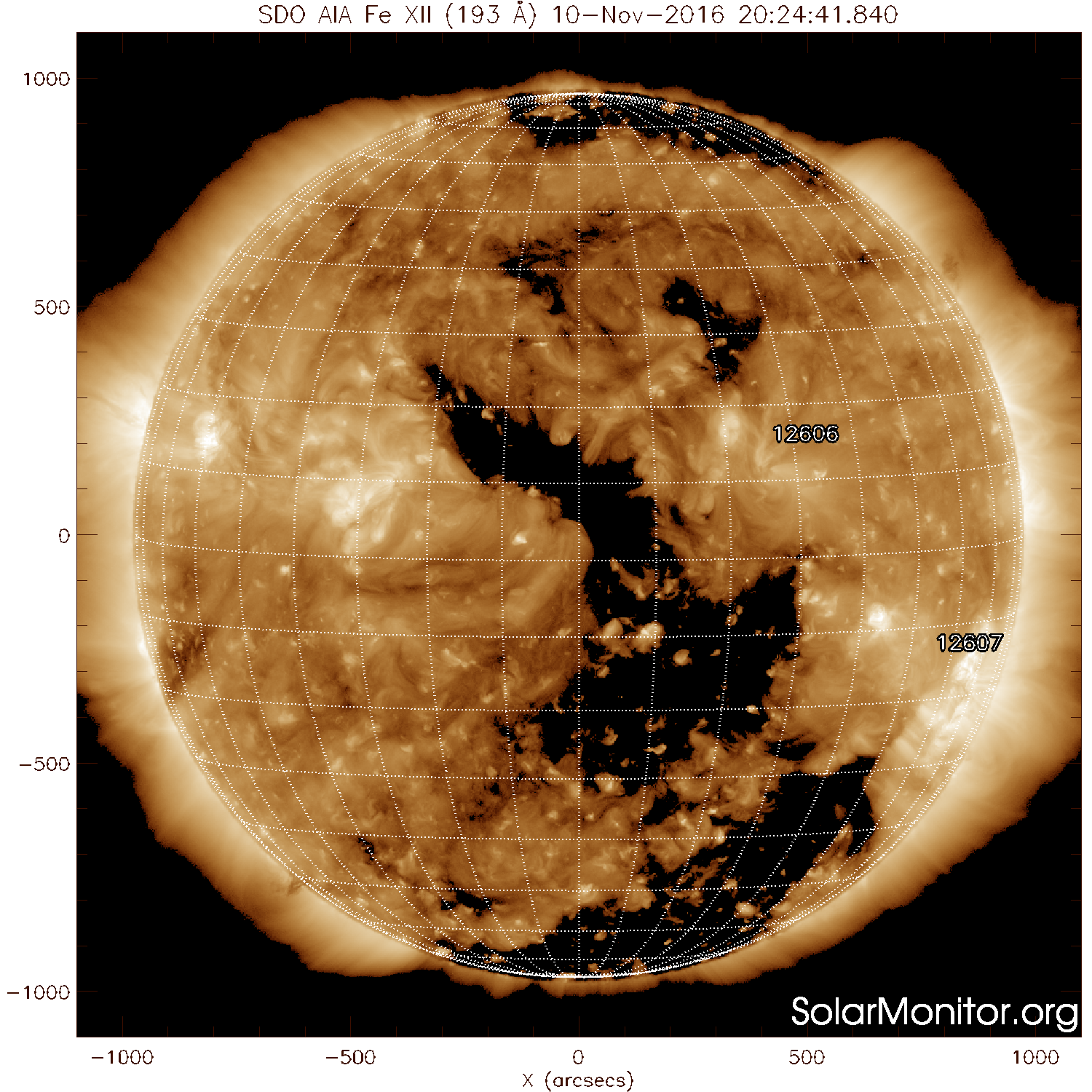
This coronal hole has been present for several Carrington Rotations and spans from south pole to north of the equator. The IMF reached a maximum of 16 nT over the week. The enhanced solar wind conditions after November 10 have only led to a lot of intervals with active geomagnetic conditions, with an isolated case of minor geomagnetic storm.
The International Sunspot Number

The daily Estimated International Sunspot Number (EISN, red curve with shaded error) derived by a simplified method from real-time data from the worldwide SILSO network. It extends the official Sunspot Number from the full processing of the preceding month (green line). The plot shows the last 30 days (about one solar rotation). The horizontal blue line shows the current monthly average, while the green dots give the number of stations included in the calculation of the EISN for each day.
Review of ionospheric activity (7 Nov 2016 - 13 Nov 2016)
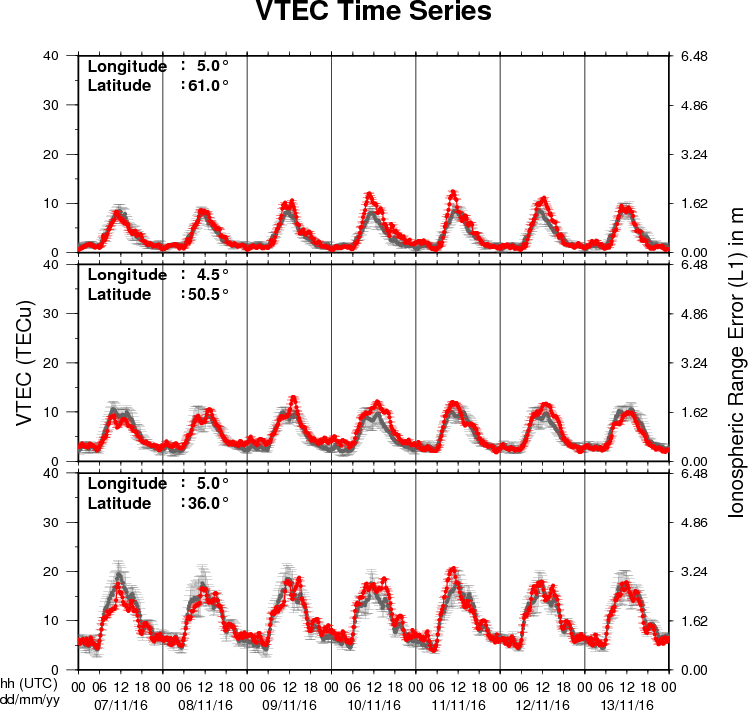
The figure shows the time evolution of the Vertical Total Electron Content (VTEC) (in red) during the last week at three locations:
a) in the northern part of Europe(N61°, 5°E)
b) above Brussels(N50.5°, 4.5°E)
c) in the southern part of Europe(N36°, 5°E)
This figure also shows (in grey) the normal ionospheric behaviour expected based on the median VTEC from the 15 previous days.
The VTEC is expressed in TECu (with TECu=10^16 electrons per square meter) and is directly related to the signal propagation delay due to the ionosphere (in figure: delay on GPS L1 frequency).
The Sun's radiation ionizes the Earth's upper atmosphere, the ionosphere, located from about 60km to 1000km above the Earth's surface.The ionization process in the ionosphere produces ions and free electrons. These electrons perturb the propagation of the GNSS (Global Navigation Satellite System) signals by inducing a so-called ionospheric delay.
See http://stce.be/newsletter/GNSS_final.pdf for some more explanations ; for detailed information, see http://gnss.be/ionosphere_tutorial.php
Future Events
For more details, see http://www.spaceweather.eu/en/event/future
4th SOLARNET Meeting: The Physics of the Sun from the Interior to the Outer Atmosphere, in Lanzarote (Spain)
Start : 2017-01-16 - End : 2017-01-20
The IV SOLARNET MEETING 'The physics of the Sun from the
interior to the outer atmosphere' will take place in Lanzarote
(Spain) from 16th to 20th of January 2017, organized by the
Instituto de AstrofÃsica de Canarias (IAC).
SOLARNET (High-resolution Solar Physics Network) is an EU-FP7
project coordinated by IAC with the aim of bringing together and
integrating the major European research infrastructures in the
field of high-resolution solar physics. SOLARNET involves all
pertinent European research institutions, infrastructures, and data
repositories. Networking activities, access to first-class
infrastructures and joint research and development activities are
being covered under SOLARNET to improve, in quantity and quality,
the service provided by this European community.
The purpose of this conference is to provide a coherent picture
of the Sun as a single physical system playing all the underlying
physical processes measured and observed in the solar atmosphere to
date.
Website:
http://www.iac.es/congreso/solarnet-4meeting/
Solar Orbiter Workshop 7: Exploring the solar environs in Granada, Spain
Start : 2017-04-03 - End : 2017-04-06
This event will be hosted by the Instituto de Astrofisica de
Andalucia - CSIC. Please mind that on April 7th the 20th SWT
meeting will take place at the same venue.
Website: Unkown
